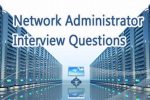Network Engineer Interview Questions and Answers
Network engineers may work internally as part of an organization’s IT Support team or externally as part of an outsourced IT networking consultancy firm working with a number of clients. Network engineers are responsible for implementing, maintaining, and supporting, developing and designing communication networks within an organization or between organizations. The work however is influenced by the size and sector of the employing organization. Following are some frequently asked Network Engineer interview questions and answers. Make your preparation with these questions and answers before appearing for your interview.
1 Q: What is a DOMAIN? What is the difference between a domain, a workgroup and a homegroup?
A: DOMAIN is created when we install Active Directory. It is a security boundary which is used to manage computers inside the boundary. Domains, workgroups and homegroups represent different methods for organizing computers in networks. The main difference among them is how the computers and other resources on the networks are managed.
2 Q: What is the difference between standard and extended ACL?
A: Standard ACL’s are source based, whereas extended ACL’s are source and destination based. Standard ACL’s can only filter layer 3 network traffic, while extended ACL’s can be used to filter layer 3 and layer 4 as well.
3 Q:. Why do we use routing?
A: By default, a router provides inter network communication only for directly connected networks. To establish communication between indirectly connected networks, we require routing. We can use static or dynamic routing according to topology requirement.
4 Q: What is the difference between switch and hub?
A: The difference between a switch and a hub is that a switch can handle multiple communications between the computers attached to it whereas a hub handle one at a time.
5 Q: What is Remote Access Services?
A: Remote Access Services refers to any combination of hardware and software to enable the remote access to tools or information that typically reside on a network of IT devices.
6 Q: What is the difference between client mail and web mail?
A: An email client is software installed on your computer that is used to access the email server your service uses. Webmail however is a server that you log into over the internet. The email client downloads your emails onto your computer the same way you download any other file from the internet. With webmail, the emails are left on your provider’s servers and that is where they stay unless you delete them. Gmail, yahoo and hotmail are the biggest names in webmail services. Outlook, Incredimail, and thunderbird are email clients that are installed on the computer and used to access email.
7 Q:. What is the difference between firewall and antivirus software?
A: A firewall is a filtering device. This filtering can be either built in or user defined. It controls incoming traffic usually by rules created by the firewall administrative to prevent invasive probing and attacks to the servers, PCs and other devices on your local or wide area network. Antivirus software is usually a scanning software with a subscription service that provides the scanner virus definitions allowing it to search files,incoming,outgoing,and stored on hard drives and other storage devices which can be potentially hazardous to your internal network or PC.
8 Q:. What is the difference between dialup and broadband?
A: A broadband connection provides high speed internet access over a standard phone line. The advantage of a broadband connection over a standard dial up service, is that Broadband is considerably faster and is always on meaning that once you are logged on, your PC is online until the PC is turned off again. Broadband offer high speed internet access and allows telephone calls and a permanent internet connection to share a single phone line simultaneously whereas in Dialup connection either internet connection or telephone call can be made at given time.
9 Q:. What is Spam guard?
A: Spam guard helps radically reduce the amount of spam you receive in your inbox by diverting most of it to your bulk mail folder. Spam guard constantly updates itself to recognize and deflect more spam each day. When turned on, emails that are sent out in bulk are delivered to your bulk mail folder and are deleted after 30 days.
10 Q: What is NIC?
A: A network card, network adapter or NIC (network interface controller) is a piece of computer hardware designed to allow computers to communicate over a computer network. A network interface card provides the computer with a dedicated full time connection to a network. Personal computers and workstations on a local area network typically contain a network interface card specifically designed for the LAN transmission technology.
Categories: Job Interview Tags: Engineer Interview, Interview Question Answers, Networking
Network Administrator Interview Questions and Answers
Network administrator is responsible for the smooth, efficient and secure operation of computer networks. They configure and administer existing networks. Their main tasks include customization of the network as per organization’s needs, adding software and hardware, troubleshooting, logging errors, helping users with network issues etc. Following are some frequently asked network administrator interview questions and answers. Before appearing for the interview for Network administrator, make sure that you have enough knowledge about the technical aspects. Mostly the questions asked in such interviews are all technical based.
1 Q: What are the critical skills a network administrator should have?
A: Network administrators need a unique blend of highly specialized technical skills along with excellent people skills. They should also possess project management skills. There is a demand for highly skilled, highly capable and highly qualified network administrators.
2 Q: How comfortable are you working in a computerized environment?
A: The work of a network administrator involves working in a computerized environment and sitting for long hours in front of the computer. The interviewer wants to find out whether you are comfortable with such an environment. Your answer should be in the positive and assure the interviewer that you are used to such environment in previous jobs.
3 Q:. What experience do you have with security support and maintenance?
A: Network administrators are responsible for implementing and maintaining regular security support. Security involves firewall installation, cryptography, back up and recovery etc. Mention in detail the experience you have in security support and maintenance.
4 Q: How do you perform system maintenance?
A: The overall function of a network administrator is to keep the system up and running. Applying latest software updates, adding and replacing hardware and adding new software are some tasks which a network administrator has to undertake for system maintenance. You can give examples from your previous jobs where you have been taking care of system maintenance.
5 Q: Are you familiar with network architecture?
A: As a network administrator, your tasks will generally fall into areas as designing and planning the network, setting up the network, maintaining and expanding the network. So a network administrator has to be familiar with network architecture. However, not all administrators specialize in the structure of computer systems.
6 Q: Do you have experience working in a team or training other employees?
A: Administrators may work alone or in teams, depending on the size and needs of the organization or department. Mention if you have experience working in a team or training employees. The interviewers view this as an added advantage for the position of network administrators.
7 Q:. What is the difference between TCP and UDP?
A: TCP stands for Transmission Control Protocol. UDP is a User Datagram Protocol. TCP can establish a connection whereas UDP cannot. TCP provides a stream of unlimited length whereas UDP sends small packets. UDP is faster for sending small amounts of data since no connection setup is required, the data can be sent in less time then it takes for TCP to establish a connection.
8 Q:. What is a VLAN?
A: A virtual local area network is a logical group of workstations, servers, and network devices that appear to be on the same LAN despite their geographical distribution. A VLAN allows a network of computers and users to communicate in a simulated environment as if they exist in a single LAN and are sharing a single broadcast and multicast domain. VLANs are implemented to achieve scalability, security and ease of network management and can quickly adapt to change in network requirements and relocation of workstations and server nodes.
9 Q:. When would you use a crossover cable?
A: If you need to connect two computers but you don’t have access to a network and can’t set up an ad hoc network, you can use an Ethernet crossover cable to create a direct cable connection. A crossover cable is constructed by reversing the order of the wires inside so that it can connect two computers directly.
10 Q: What is virtual path?
A: The location of a file or directory on a particular server, as seen by a remote client accessing it via World Wide Web. A virtual path provides access to files outside the default directory and subdirectories. An access control list can be associated with a virtual path.
11 Q: Describe DHCP.
A: Dynamic Host Configuration Protocol is a client/server protocol that automatically provides an Internet Protocol host with its IP address and other related configuration information such as the subnet mask and default gateway. DHCP allows hosts to obtain necessary TCP/IP configuration information from a DHCP server. The DHCP server service provides benefits such as reliable IP address configuration and reduced network administration.
12 Q: Define stuck in active.
A: If a successor route (best route) fails, then the router sends a query message to its neighbor demanding a feasible successor (back up route) and a query received by the router may be forwarded to other neighbors that could lead to a loop, as well. The wait for the response of query message is called stuck in active.
13 Q: What is route reflector and why is it required?
A: Route reflector is a solution for BGP split horizon. The rule says prefix learned from an IBGP neighbor will not be advertised to another IBGP. To overcome this situation, options include make your network a full mesh, route confederation and confederation. Route reflector is something like a central point acting as a route reflector server. Rather than peering with every IBGP router in a full mesh, it makes IBGP neighbors as route reflector clients to overcome the split horizon issue.
Categories: Job Interview Tags: Administrator Questions, Interview Questions, Networking
Computer Hardware and Networking Interview Questions and Answers
For Computer Hardware and Networking Job Interview one has to have all technical concepts cleared. The questions are based on the concepts you know in Computer hardware and networking. You need to have a clear base of all the concepts for successfully getting a job in this field. Below mentioned are some computer hardware and networking interview questions and answers. However you should be prepared for other questions as well because computer hardware and networking is a broader field with many concepts. Most frequently asked computer hardware and networking interview questions and answers are given for your reference.
1 Q: What are routers?
A: A router is a device that forwards data packets along networks. Routers can connect two or more network segments. Router functions in an Internet protocol based network operate at the network layer. Routers store information in its routing table such as paths, hops and bottlenecks.
2 Q: What is the difference between Intranet and Internet?
A: Internet is a broad public network that anyone can access through an Internet Service Provider while intranet is a privately owned part of the internet under which only a selected number of IP’s are allowed to communicate. The primary difference between the Internet and the Intranet is about accessibility.
3 Q:. Explain Domain Name System.
A: A domain name is the information that you enter into a web browser in order to reach a specific website. Domain name system is the way that Internet domain names are located and translated into Internet Protocol addresses. DNS naming is used in TCP/IP networks, such as the Internet , to locate computers and services through user friendly names.
4 Q: What is MAC address?
A: MAC, Media Access Control, address is a hardware identification number that uniquely identifies each device on a network. The MAC address is manufactured into every network card, such as Ethernet card or WIFI card, and therefore cannot be changed. MAC addresses are 12 digit hexadecimal numbers(48 bits in length).
5 Q:. Describe data encapsulation.
A: Data Encapsulation also known as data hiding refers to sending data where the data is augmented with successive layers of control information before transmission across a network. The user can only perform a restricted set of operations on the hidden members of the class by executing special functions commonly called methods.
6 Q:. What are the different ways of securing a computer network?
A: There are different ways of securing a computer network. Some of them are use of Virus Protection software, use firewall program , authenticate users etc. All these combined together will provide securing a computer network.
7 Q:. Describe the function of the OSI Session Layer.
A: The function of the OSI Session layer is to establish, manage and terminate sessions between communicating hosts. This layer also synchronizes dialog between the presentation layer of the two communicating hosts and manages their data exchange. The session layer offers provisions for efficient data transfer , class of service and exception reporting of session layer, presentation layer and application layer.
8 Q:. What is WAN?
A: WAN stands for Wide Area Network. WAN consists of two or more local area networks (LANs) and this computer network spans a relatively large geographical area. The largest WAN in existence is the Internet.
9 Q:. Explain the functionality of PING.
A: The functionality of PING command is that it allows to test the connection speed between your network and another network node. Basically it is used to check whether the system is in network or not. By using PING command, you can tell the strength, distance and availability of a connection either in your own network or over the internet.
10 Q: When is a switch said to be congested?
A: It is possible that a switch receives packets faster than the shared link can accommodate and stores in its memory , for an extended period of time, then the switch will eventually run out of buffer space , and some packets will have to be dropped and in this state a switch is said to be in a congested state.
11 Q:. What is the difference between POP3 and IMAP Mail Server?
A: POP3 is a protocol to download and locally store your emails. When your client connects it will download all mail stored in your mailbox and save it to your hard disk. It will then by default delete the copy that is held on the servers. IMAP Mail Server is a protocol used to access and manipulate the contents of the mailbox on the server in real time. You can open mails, create folders to store mails, delete messages from the server and otherwise use the system as normal.
12 Q: What is Gateway of Last Resort?
A: Gateway of Last Resort also known as Default Gateway is used when a router does not know about the destination network of a packet it has received. In other words, it is a route used by the router when no other known route exists to transmit the IP packet. Known routes are present in the routing table. Hence any route not known by the routing table is forwarded to the default route.
13 Q: What is the difference between memory and hard disk space?
A: Memory is RAM (Random Access Memory). RAM is a collection of electronic circuitry where your computer’s programs and data are stored when it is running. The hard disk drive which typically resides in the computer but nowadays external hard drives is also available. A computer’s memory is used for temporary storage while a computer’s hard drive is used for permanent storage.
Categories: Job Interview Tags: Interview Questions, Networking



